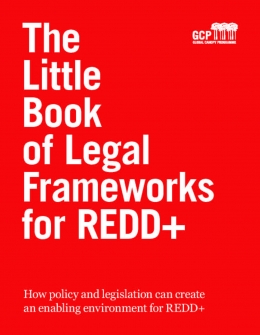The Little Book of Legal Frameworks for REDD+
Year:
2015
Publisher:
Global Canopy Programme
Place:
Oxford
Land-use change, including deforestation, is currently estimated to generate about 3.3 billion tonnes of tonnes of carbon emissions per year – approximately 10% of all human emissions1. REDD+ has emerged in response to this, as an international initiative that aims to provide financial incentives to developing countries for ‘reducing emissions from deforestation and forest degradation’. This initiative could soon be included as a key climate change mitigation mechanism within a new global climate change agreement, to be negotiated by 2015 under the United Nations Framework Convention on Climate Change (UNFCCC). For forest countries preparing to implement REDD+ and receive results-based payments, a clear domestic legal framework of enabling policies and legislation is needed to ensure that national systems not only deliver permanent emission reductions, but can also guard against the social and environmental risks created by REDD+, while also delivering co-benefits.
A variety of international requirements and guidance exist for forest countries looking to participate in REDD+, including those adopted by Parties to the UNFCCC, as well as those defined by a number of multilateral and bilateral REDD+ initiatives, which are already delivering finance for ‘REDD+ readiness’. Recognising the diversity of country circumstances, this book describes the ways in which forest countries can use their domestic legal frameworks to meet the key requirements of the UNFCCC and those of the World Bank Forest Carbon Partnership Facility.
Furthermore, it explains how domestic legal frameworks can be used to address a number of broader governance issues which are also critical for achieving effective, efficient and equitable REDD+. These include reducing corruption, and ensuring rights of access to information and public participation.
Finally, for decision makers wishing to pursue a more integrated approach to land-use management – i.e. a ‘landscapes approach’ – the analysis presented here may offer useful guidance for achieving greater cohesiveness and coordination across the different land-use sectors.
This book does not present a one-size-fits-all approach, but a range of potential solutions, which are flexible and can be adapted to individual countries as they work towards reducing forest emissions in the ways best suited to their unique circumstances.
Reference URL:
Work regions:

Files:
